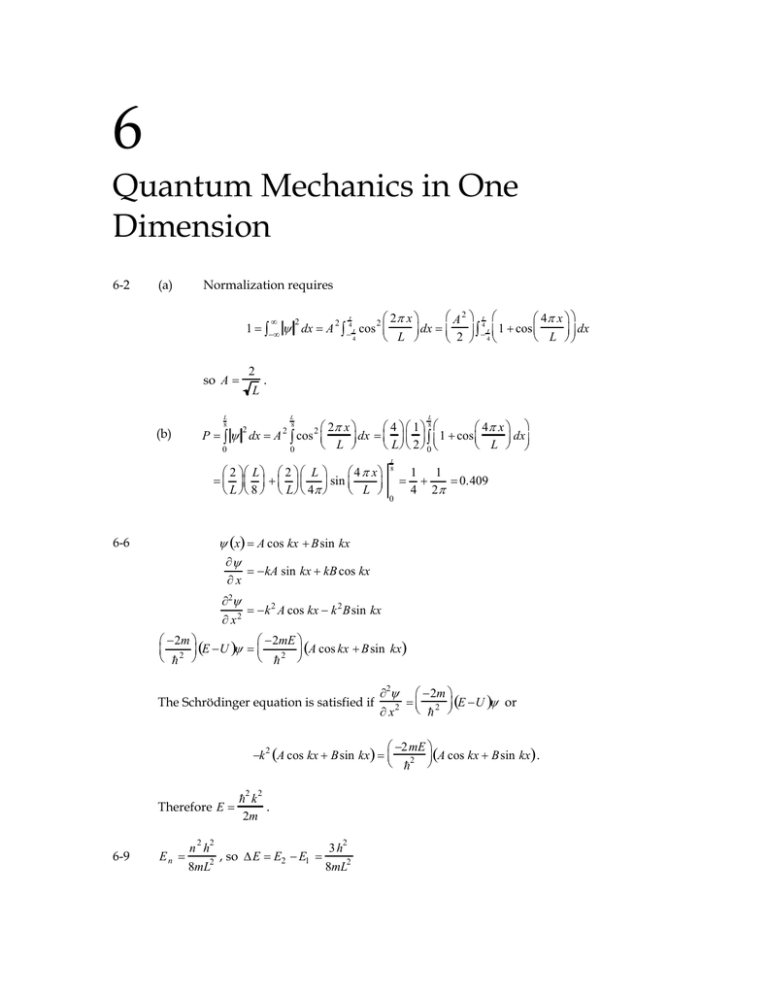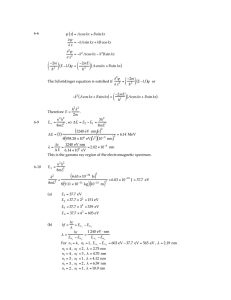6 Quantum Mechanics in One Dimension
advertisement

6 Quantum Mechanics in One Dimension 6-2 (a) Normalization requires L A 2 L 4 x 2 2 2 2 x 1 dx A 4 L cos dx 4 L 1 cos dx L L 2 4 4 2 . L so A (b) L 8 L 8 L x 4 1 8 4 x P dx A cos dx 1 cos dx L L 2 0 L 0 0 2 2 2 2 2 L 2 L 4 x sin L 8 L 4 L L 8 1 1 0.409 4 2 0 x A cos kx Bsin kx 6-6 x kA sin kx kB cos kx 2 k 2 A cos kx k 2 Bsin kx x2 2m 2mE 2 E U 2 A cos kx Bsin kx The Schrödinger equation is satisfied if 2 x 2 2m 2 E U or 2mE 2 k A cos kx Bsin kx A cos kx Bsin kx . 2 k 2 Therefore E . 2m 6-9 En n 2 h2 2 8mL , so E E2 E1 3h2 2 8mL E 3 1240 eV nm c 2 8 938.28 106 eV c2 10 5 nm 2 6.14 MeV hc 1240 eV nm 2.02 10 4 nm E 6.14 106 eV This is the gamma ray region of the electromagnetic spectrum. 2 2 6-10 En n h 2 8mL 2 6.63 10 34 Js h2 8mL2 8 9.11 10 31 kg 10 10 m 2 6.03 10 18 J 37.7 eV E1 37.7 eV (a) E2 37.7 22 151 eV E3 37.7 3 339 eV 2 E 4 37.7 4 2 603 eV hf (b) hc En i En f 1 240 eV nm hc En i En f E n i En f For n i 4 , nf 1 , E n i E n f 603 eV 37.7 eV 565 eV , 2.19 nm ni ni ni ni ni 4, 4, 3, 3, 2, nf nf nf nf nf 2 , 2.75 nm 3 , 4.70 nm 1 , 4.12 nm 2 , 6.59 nm 1 , 10.9 nm 6-12 3 8 h h2 2 2 L 1 and 2 E 8mL2 mc 6-13 (a) hc 12 7.93 10 10 m 7.93 Å. Proton in a box of width L 0.200 nm 2 10 10 m 6.626 10 34 J s 8.22 10 22 J E1 8m p L2 81.67 10 27 kg 2 10 10 m 2 2 h2 (b) 8.22 10 22 J 1.60 10 19 J eV 5.13 10 3 eV Electron in the same box: 6.626 10 34 J s E1 8me L2 89.11 10 31 kg 2 10 10 m 2 h2 2 1.506 10 18 J 9.40 eV . 6-16 (c) The electron has a much higher energy because it is much less massive. (a) x x A sin , L 3 Å. Normalization requires L L L x LA 2 2 1 dx A 2 sin 2 dx L 2 0 0 12 2 so A L 3 12 L3 2 2 3 2 2 2 x 2 0.195 5 . dx sin dx sin d L 0 L 0 8 0 6 L3 P 100 x 2 , A L L 12 (b) A sin P L3 100 3 100 x 200 2 L 1 100 1 2 sin sin d dx 3 L L 100 0 50 6 4 2 sin 0 1 1 2 1 3 0.331 9 sin 3 3 3 400 200 1 . 3 Since the wavefunction for a particle in a one-dimension box of width L is given by n x 2 2 2 n x n A sin , it follows that the probability density is Px n A sin L L which is sketched below: (c) 6-18 2 L Yes: For large quantum numbers the probability approaches 2 3 2 From this sketch we see that Px is a maximum when when 5 2 n x L n x L 2 , 3 5 1 , , m or 2 2 2 x L 1 m 2 n Likewise, Px is a minimum when x 6-24 m 0, 1, 2, 3, , n . n x 0 , , 2 , 3 , m or when L Lm n m 0 , 1, 2, 3 , , n After rearrangement, the Schrödinger equation is U x d2 2m U x E x with 2 2 dx 1 2 2 x 2 gives m x for the quantum oscillator. Differentiating x Cxe 2 2 d 2 x x C x dx and d2 dx 2 2 xd dx 2 x 2 x Ce x 2 x x 6 x . 2 2 2 2 m 2 2mE 2m Therefore, for x to be a solution requires 2 x 6 2 U x E x 2 . m m 2 mE Equating coefficients of like terms gives 2 and 6 2 . Thus, and 2 3 2 3 2 2 2 2 x 2 dx where the . The normalization integral is 1 x dx 2C x e E 2 m second step follows from the symmetry of the integrand about x 0 . Identifying a with 2 in 1 4 32 3 or C . At its limits of vibration x A the classical oscillator has all its energy in potential form: 12 1 the integral of Problem 6-32 gives 1 2C 8 2 2 6-25 12 1 2E 1 m 2 A 2 or A . If the energy is quantized as E n n , then the 2 m 2 2 12 2n 1 corresponding amplitudes are A n . m E 6-29 (a) Normalization requires 2 1 dx C 2 e 2x 1 e x dx C 2 e 2x 2e 3x e 4x dx . The integrals are 2 0 0 1 1 1 C2 elementary and give 1 C2 2 . The proper units for C are those of 2 3 4 12 length 1 2 thus, normalization requires C 12 12 nm 1 2 . (b) 2 The most likely place for the electron is where the probability is largest. This is d also where itself is largest, and is found by setting the derivative equal zero: dx 0 d x 2x x x C e 2e Ce 2e 1 . dx The RHS vanishes when x (a minimum), and when 2e x 1 , or x ln 2 nm . Thus, the most likely position is at x p ln 2 nm 0.693 nm . (c) The average position is calculated from 2 x x dx C 2 xe 2 x 1 e x dx C2 x e 2 x 2e 3 x e 4 x dx . 2 0 0 The integrals are readily evaluated with the help of the formula xe ax dx 1 1 1 13 x C 2 2 C2 . Substituting C2 12 nm 9 4 16 144 x 0 1 1 a2 to get gives 13 nm 1.083 nm . 12 We see that x is somewhat greater than the most probable position, since the probability density is skewed in such a way that values of x larger than x p are weighted more heavily in the calculation of the average. 6-31 The symmetry of x about x 0 can be exploited effectively in the calculation of average values. To find x 2 x x x dx 2 We notice that the integrand is antisymmetric about x 0 due to the extra factor of x (an odd function). Thus, the contribution from the two half-axes x 0 and x 0 cancel exactly, leaving x 0 . For the calculation of x 2 , however, the integrand is symmetric and the halfaxes contribute equally to the value of the integral, giving x x 2 dx 2C2 x 2 e 2 x x 0 dx . 0 2 0 3 x0 Two integrations by parts show the value of the integral to be 2 . Upon substituting for 2 12 x 2 x C , we get x 0 0 . In calculating 2 2 the probability for the interval x to x we appeal to symmetry once again to write 2 2 1 x 3 x 2 2 2 0 0 and x x 2 x 2 x0 2 P x x 2 12 x x 2 2x x 0 dx 2C 2 0 e 2x x 0 dx 2C e 2 2 x 0 1 e 2 0.757 0 or about 75.7% independent of x0 . 1 4 6-32 2 a 2 ax 2 The probability density for this case is 0 x C0 e with C 0 m and a . For the calculation of the average position x x 0 x dx we note that the integrand is an 2 odd function, so that the integral over the negative half-axis x 0 exactly cancels that over the positive half-axis ( x 0 ), leaving x 0 . For the calculation of x 2 , however, the integrand x 0 2 2 is symmetric, and the two half-axes contribute equally, giving x 2 2 ax 2 2 C0 x e 2 0 12 2 1 dx 2C 0 4 a a . 1 2 Substituting for C 0 and a gives x 2 and x x x 2 a 2m 6-33 2 12 12 . 2 m (a) Since there is no preference for motion in the leftward sense vs. the rightward sense, a particle would spend equal time moving left as moving right, suggesting px 0 . (b) To find p2x we express the average energy as the sum of its kinetic and potential px2 px2 U U . But energy is sharp in the 2m 2m 1 oscillator ground state, so that E E0 . Furthermore, remembering that 2 1 2 2 2 from Problem 6U x m x for the quantum oscillator, and using x 2 2m m 1 1 2 32, gives U m 2 x 2 . Then px 2mE0 U 2m . 4 2 2 4 energy contributions: E (c) px p2x px 2 12 12 m 2 12 6-34 From Problems 6-32 and 6-33, we have x 2m 12 12 12 m and px . Thus, 2 m xpx for the oscillator ground state. This is the minimum 2m 2 2 uncertainty product permitted by the uncertainty principle, and is realized only for the ground state of the quantum oscillator.





